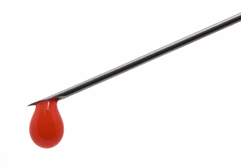 Safe in Common has issued a list of “10 Golden Rules” of safety relating to the design, implementation and use of safety sharps.
Safe in Common has issued a list of “10 Golden Rules” of safety relating to the design, implementation and use of safety sharps.
- The design and activation of the safety mechanism is automatic and will not interfere with normal operating procedures and processes
- The device is intuitive and requires no additional steps for use than equivalent standard/conventional device
- The contaminated, non-sterile sharp will be rendered safe prior to removal or exposure to the environment
- Activation of the safety mechanism does not require the healthcare worker to undertake any additional steps during normal process/protocols providing patient care
- Activation of the safety mechanism will not create additional occupational hazards (such as aerosolization, splatter, exposure to OPIM, etc.)
- Activation of the safety mechanism does not cause additional discomfort or harm to the patient
- The device will be ergonomically designed for comfort, allowing for automatic one handed use during all stages of patient procedure
- The safer engineering control is available in sizes and iterations appropriate for all areas of use relevant to the patient care needs
- Disposal of Safety Device will not increase waste disposal volumes but should incorporate designs to reduce waste
- The used safety device will provide convenient disposal and mitigate any risk of reuse or re-exposure of the non-sterile sharp
Some of these seem to be blindingly obvious. However, many NHS Trusts are purchasing the cheapest available device – cost in noticeably and rightly excluded from the 10 selection and performance criteria – that may not comply with all of the 10 Golden Rules.
But all seems fine with these Golden Rules, except for one or two issues that are worthy of further consideration.
That safety sharps should not increase waste disposal volumes but should incorporate designs to reduce waste is a laudable aim that might be set before the manufacturer of any disposable device, whether sharps related or not. Can it be achieved? Though clearly against bloated constructions that massively increase device weight or volume the additional complexity of an automatic safety device is unlikely to be achieved in a smaller or lighter device except through the use of new and innovative materials. However, as these devices must be packaged and sterilised to comply with a hugely complex set of performance and safety standards, a net decrease in waste volumes seems improbable.
“Rule” number 10, that the used safety device will provide convenient disposal and mitigate any risk of reuse or re-exposure of the non-sterile sharp is obviously a key requirement, and might probably elevated to Rule #1. But what does it really say about safety sharps devices? If an acceptable safety sharps device must be automatic (#1) and such as to mitigate any risk of reuse or re-exposure (#10) then can we do away with sharps bins, which would lead to great simplification of clinical waste disposal delivering many advantages without any adverse safety implication.
Remember, you heard that first on the Clinical Waste Discussion Forum.
